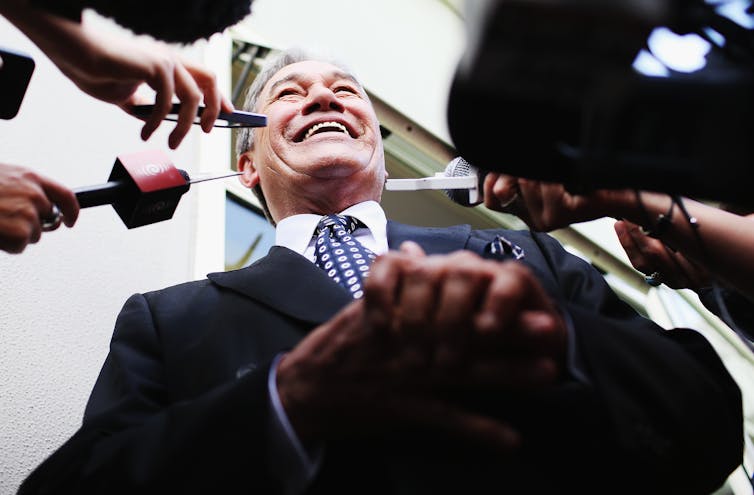Here go again. The final results of this year’s election have delivered two more seats to te Pati Māori, thereby increasing the size of New Zealand’s 54th Parliament to 123 seats (once the Port Waikato by-election has taken place).
The double effect of this “overhang” is to erase the narrow election night majority held by National (who have lost seats via special votes for the seventh election on the trot) and ACT, and to hand the balance of power to NZ First.
The irony that te Pati Māori’s performance forces three parties who are, at best, lukewarm on the idea of Māori seats into formal negotiations won’t be lost on anyone. The larger point, however, is that the results fundamentally change the dynamics of the process required to form the next government.
Until now, contact between National and NZ First has been framed as a means by which Chris Luxon and David Seymour shore up the narrowest of parliamentary majorities. But National and ACT cannot now get to that majority without NZ First.
Once again, as he was in 1996 and 2017, Peters is in the veto position, holding the “balance of responsibility” (as he called it in 1996, and will likely start doing so again) and central to the process of government formation.
Phil Walter/Getty Images
A brief history of Winston
Given this, it is worth recalling what happened the last time Peters put National in office. The parallel discussions NZ First held with National and Labour following New Zealand’s first MMP election in 1996 took two months to complete, and Peters’ decision to go with National was made just hours before the public announcement of the coalition.
Prime Minister Jim Bolger was informed of this after Peters’ televised press conference had begun, but Helen Clark, Labour’s leader, learned of the decision at the same time the rest of the country did.
The process produced the most detailed coalition agreement New Zealand has seen. The document ran to some 50 pages and included detailed commitments in 36 policy domains, a statement of fiscal parameters for the new government’s operations and a supplementary agreement on a range of matters that were not resolved during negotiations.
Read more:
Long live the kingmaker: Winston Peters and the NZ election
Peters secured five Cabinet seats and a further four positions outside Cabinet, as well as a commitment – somewhat bizarrely – that NZ First would take three more seats at the top table in 1998. The government didn’t survive that long, but you can see why this provision angered many within National.
Peters also took on the specially created role of Treasurer, the offer of which swung his decision to go with National. In fact, the books were run by the Finance Minister, National’s Bill Birch, but the splitting of the finance portfolio gave NZ First leverage without making Peters an associate to Birch.
And the whole thing fell apart within two years. Jim Bolger was rolled by Jenny Shipley a year after the election, and the relationship between the new prime minister and her deputy rapidly deteriorated: Shipley sacked Peters and formally dissolved the coalition in August 1998.
Given this history, you imagine that Chris Luxon, Nicola Willis and the rest of National’s senior leadership will be approaching the next few weeks warily.

Hannah Peters/Getty Images
Where to from here?
There is much to be done, including establishing the precise shape of the government. Will it be a formal three-party coalition, or will one of the smaller parties sit outside the executive, supporting it on confidence and/or supply?.
Ministerial portfolios will also need to be distributed – members of three parties will probably be competing for a limited number of positions. This means there there are going to be some very disappointed people – who might, over the long-term, become disruptive.
Just as important will be any decisions taken regarding the arrangements for the day-to-day management of the government. These will attract less public attention, but the rules that coalition partners agree to play by are critical – and were at the centre of the collapse of the National/NZ First administration in 1998.
Negotiation likely to take time
While there is no constitutional requirement to have negotiations wrapped up by the December 21, which is the last date by which the new parliament must meet, there is a strong political incentive to do so. It will be a bad look if Luxon cannot get his administration organised by Christmas.
One thing is clear: while Peters can negotiate governing arrangements in his sleep, Seymour has little experience of what it takes to form a government and Luxon has none whatsoever. Indeed, the last time Peters sat down to hammer out a deal with the National Party, Luxon was just three years into his time at Unilever and Seymour was 13 years’ old.
Read more:
Jacinda Ardern to become NZ prime minister following coalition announcement
Adding to the intrigue – especially given the premium Peters apparently places on respect – is the animus between Peters and Seymour. Luxon’s pre-election position on talking with Peters – which might generously be characterised as tepid – will also not have gone down well at NZ First headquarters.
And while Peters has, in the past, professed disdain for the baubles of office, he might well demand his beloved Foreign Affairs, or another stint as Treasurer (to the fortunate Nicola Willis’ Minister of Finance). Or seek to deny others – Seymour, perhaps – those baubles.
No one knows what the coming days (or weeks) have in store. We are now at that point in political time when bottom lines become guidelines, and conversations that were categorically ruled out start taking place. But we should expect the unexpected when Winston Peters does eventually exercise the “balance of responsibility”.
Credit: Source link




